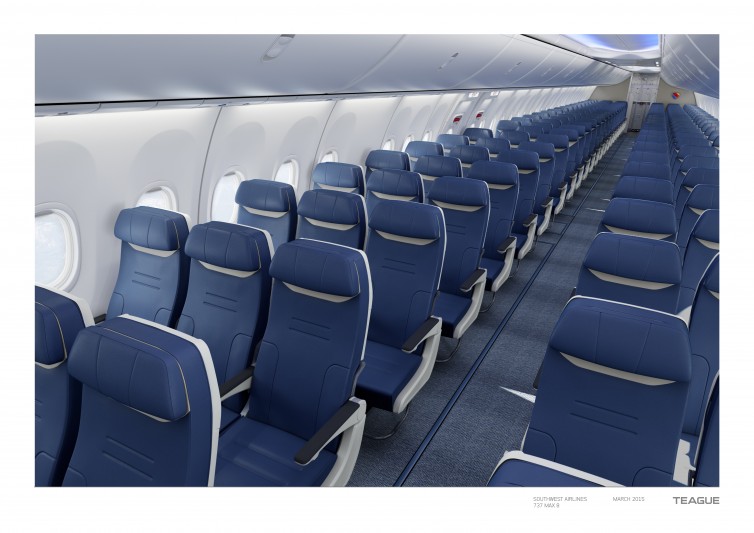
Cabin mockup of the 737 MAX 8 with the new Meridian seats – Image: Southwest Airlines
I recently attended Southwest’s #SWAmediaDay and the unveiling of their new Houston Hobby international terminal. As an unabashed Southwest fan, and card-carrying A-Lister (Southwest’s version of elite frequent flyer), it was an excellent opportunity to get up-to-date on what’s going on behind the scenes at Southwest. But the exhibit which stole the show for me? Finally, a pair of the mysterious new blue Meridian seats for my eyes (and derrià¨re) to literally size up.
Over the past few years I’ve noticed an interesting trend: Airlines release new slimline seats, talking them up to make them seem as if they are greatest innovation to passenger experience since the advent of the jet engine. Immediately following, passengers (and media) quickly cry afoul, often before trying the seats out. Because, all change is bad, right? Who moved my cheese?! If we were to try to find middle ground between these two extremes we might arrive at an analogy comparing slimlines to the Rolls-Royce RB211. A jet engine for sure, but by all accounts an expensive flop which had a part in destroying Rolls Royce, crippling Lockheed, and being one of just a few factors which killed the L-1011 TriStar.
But, I digress… We are talking about something as benign as seats after all, right?
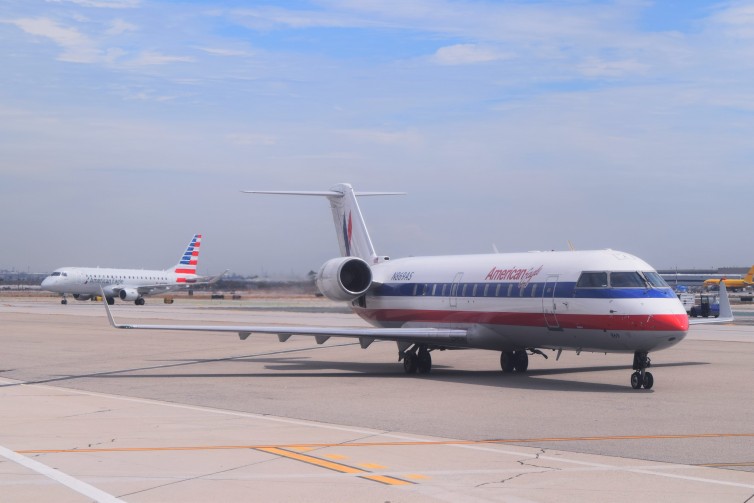
An American Eagle CRJ200 taxiing at LAX, with an Embraer 175 following – Photo: John Nguyen | AirlineReporter
Let’s face it… the 50-seat Bombardier CRJ200 isn’t very popular. At all. You’ll find countless articles and blogs about how much flyers dread flying in it, and how all-around terrible the experience was. Complaints were numerous: claustrophobic cabin, tiny overhead bins that fit only the smallest of carry-on bags, no first class, inoperable lavatories, and so on. This wasn’t limited to just one airline either; CR2s are found in the regional fleets for most of the major U.S. airlines. Coincidentally, many of them are operated under contract by the same regional carrier, SkyWest Airlines.
Does the CR2 deserve its bum rap? Maybe, maybe not (but probably). For some passengers, however, there is hope just over the horizon…
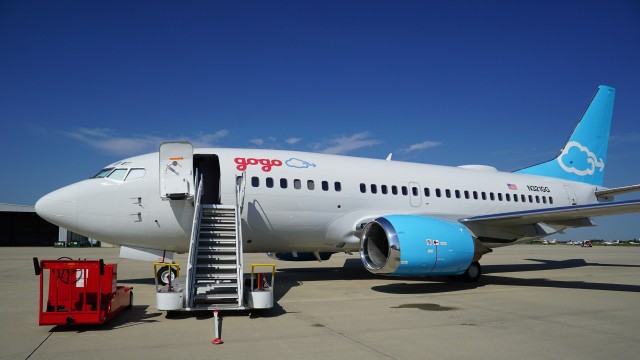
N321GG – Gogo’s 737-500 testbed – Photo: Gogo
Like most business travelers, I have grown accustomed to looking for the familiar WiFi symbol while boarding a plane. Just a few years ago, in-flight connectivity was a luxury and something one could not depend on, whether through spotty deployment across fleets, or because the cutting-edge technology delivering said connectivity wasn’t terribly reliable.
Over the years, however, following increased adoption among carriers, this luxury has morphed into something closer to a necessity. Business travelers like consistency, yet as comedian Louis CK accurately pointed out in one of his more popular skits amongst AvGeeks, we are more entitled than we should be. While I have grown increasingly dependent on connectivity, the underlying technology has always been a bit of a black box to me. You’ll be happy to know the hardware is in-fact encased in black boxes.
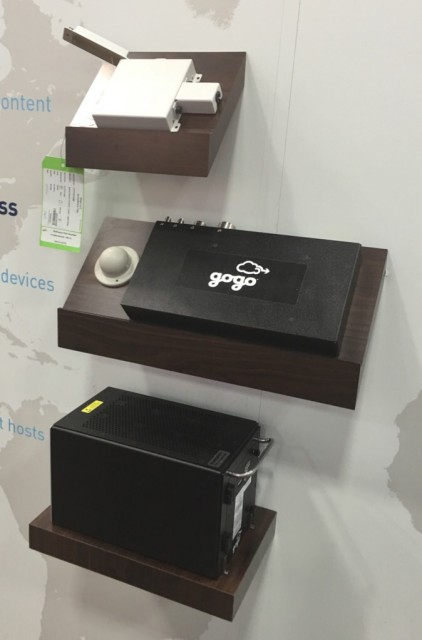
Some of the hardware required to power Gogo’s IFC and IFE systems – Photo: JL Johnson | AirlineReporter
I recently had the opportunity to catch up with the Gogo team at the Airline Passenger Experience Association (APEX) Expo in Portland to learn all about in-flight connectivity. For two days I mingled with PR folks, engineers, and even some of Gogo’s competitors in an attempt to get a solid understanding of IFC basics. Now that I have had a few days to digest the the technology and various initialisms, I’m excited to share what I learned.
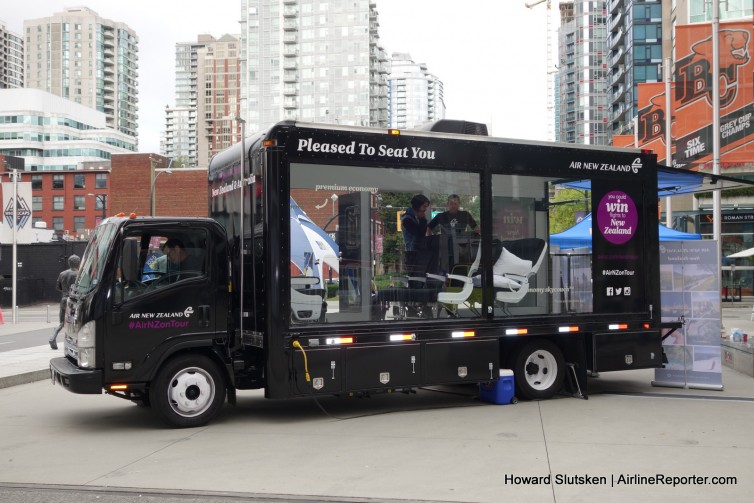
Air New Zealand’s “Pleased to Seat You” truck on display in Terry Fox Square in Vancouver
Air New Zealand is in the midst of refurbishing its Boeing 777-200ER fleet, and is showcasing the planes’ new Premium Economy and Economy Skycouch seats during a North American ’œPleased to Seat You’ tour.
The seats are on display in a 26 foot, 5 ton, glass-walled truck that will cover more than 7,000 miles, giving the public a chance to see and sit in the -200’s new seats. The airline introduced the innovative Skycouch in its Boeing 777-300s ’“ the footrest in a row of three seats can be positioned at the same height as the seat cushions, giving a flexible space for passengers.
With the update of the -200s, all of the long-haul aircraft in Air New Zealand’s fleet will include the Skycouch, along with the new Premium Economy seats also found in its Boeing 787-9s.
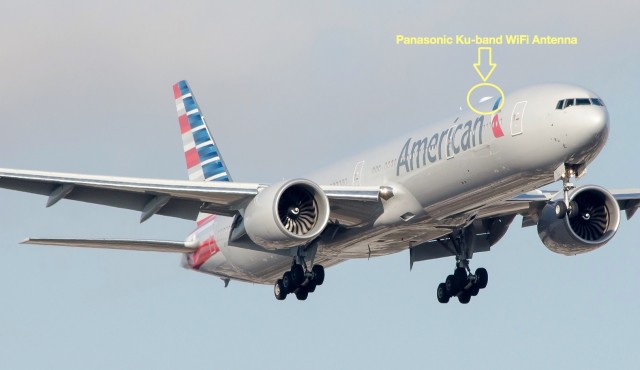
WiFi is becoming common, but doesn’t mean it isn’t complex – Photo: Jason Rabinowitz
A few weeks ago, Gizmodo ran an article claiming to rank and explain every major U.S. carrier’s WiFi system. At Routehappy, a big part of my job is to do exactly that. I need to know exactly what WiFi system is installed on every airline fleet and subfleet in the world, how it performs, what its limitations are, and how it ranks in the overall ecosystem. When I read through this article, I couldn’t help but notice it contained a few errors.
It’s a very complicated ecosystem, but not so complicated that it can’t be figured out. While the article does a great job of explaining how in-flight WiFi works and the technology behind it, I felt it was necessary to clear up which airlines currently offer what systems. Gizmodo’s 1-9 ranking is unchanged.
Below are excerpts from the original Gizmodo article, with my comments added under each.





